SaaS pricing strategy is the most critical part of a SaaS business. If the product is underpriced, you are leaving money on the table. For example: If a product is saving millions of dollars for a business, the pricing should be such that the business recovers those millions of dollars over the lifetime of the customer. Similarly, if the product is overpriced, you might lose out on potential customers. Hence, it becomes very important for every SaaS founder to understand the various types of pricing models for SaaS businesses in order to price their SaaS appropriately. This blog explains the various types of SaaS pricing models in detail.
Types of SaaS Pricing Models
- Flat Rate Pricing
- Usage-Based Pricing
- Tiered Pricing Strategy
- Per-User Pricing
- Per Active User Pricing
- Per Feature Pricing
- Freemium Business Model
- Hybrid Pricing Model
- A la Carte Pricing Model
- Volume Based Pricing
- Time-based Pricing
Flat Fee Pricing:
The flat fee pricing model is not one of the widely used pricing models in the SaaS industry. This model involves charging a fixed fee for a fixed set of features that the product offers. It is best for those products whose buyers fall into a single persona.
Benefits:
- Eliminates complexity: A single price becomes easy for the customer to understand. It doesn’t lead the customers into the confusion of deciding which plan best suits their requirements especially if the product’s target audience is put off by complexity.
- Easy Revenue Formula: For first time sellers, charging a fixed price gives them a straight revenue formula, which makes it easier for them to keep a track of their financials.
Drawbacks:
- Vulnerable to price wars: You may not be able to capture maximum value from your customers because you will be vulnerable to price wars. If your competitors reduce the price, you would tend to undercut them in order to penetrate the market, losing ARPU in the process.
- Lack of flexibility: Flat fee pricing leaves no flexibility with the business to get the prospect into buying the product with a plan that best suits his/her requirement.
Example: Basecamp is a project management and team collaboration tool that uses the Flat Fee pricing model. It currently charges a fixed price of $99/month for the product. Basecamp’s mantra was simplicity. It has kept the product and the pricing easy to use and straightforward which does not overwhelm the customer in any way. Unlike most of the SaaS companies which have various pricing plans and product offerings to cater to different personas, Basecamp has just one product plan with all the features- the growth secret for BaseCamp. The users hardly have difficulty in understanding the product or the pricing. Moreover, unlike other SaaS businesses, which cater to the SMB segment as well as the Enterprise segment through different product plans, BaseCamp does not focus on the Enterprise segment, so its customer personas are not very different from each other. Therefore, a Flat-Fee pricing model works well for BaseCamp.
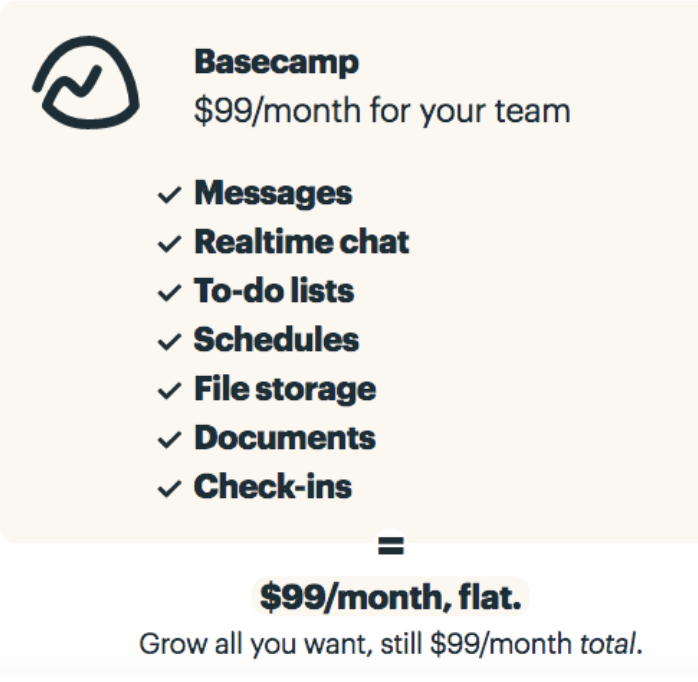
When to use?
- Customers’ personas for your product are not very different from each other.
- Your bundled product can cater to various personas at the same time
- Your customers place a high value on simplicity
Usage-Based Pricing:
Charging on the basis of the usage. Through this pricing, the bill of your customers might increase or decrease as a result of their usage of the product. Many cloud telephony companies bill the customer on the basis of the number of minutes.
Benefits:
- Heavy User Costs: There are always some users who use the product heavily in which case the company loses out on revenue by charging a fixed-fee. Hence, usage-based pricing is the right way to price if the product has a higher number of Heavy Users.
- Easily scalable pricing: Under usage-based pricing, the pricing can be easily scaled on the basis of usage, therefore, giving the best value to the customer as well as the company.
Drawbacks:
- Difficult to predict revenue: Since the pricing depends on usage and usage is often unpredictable due to a number of seasonal factors that affect the business, it often becomes difficult to forecast revenue.
- Difficult to predict costs: For the customers, it becomes difficult to predict their own costs and plan their budget accordingly due to uncertainty in the amount of usage.
Example: Messagebird is a customer service software that powers business communication. It charges its users on the basis of their usage. It charges $0.006 for each outbound SMS and voice call. Usage-based pricing makes perfect sense for Messagebird because often it is difficult to predict the subscriber’s usage due to unpredictability in the inflow and outflow of calls and messages – the same reason why businessmen prefer postpaid over prepaid plans.
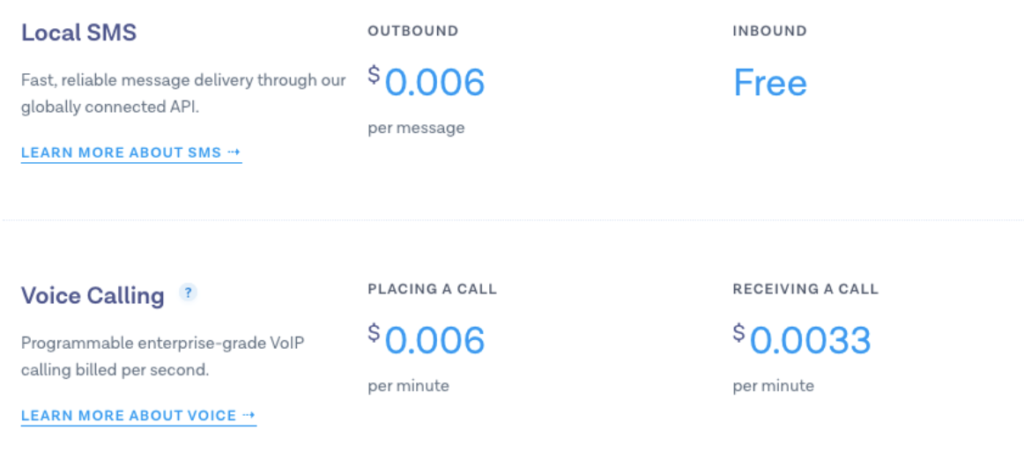
When to use?
- The usage of your product by customers is unpredictable
- A higher proportion of your customers are heavy users
- Your customers expect easily scalable pricing due to unpredictability in usage
Tiered Pricing Strategy:
The tiered pricing model is one of the most widely used pricing models in the SaaS industry. It offers different plans, each plan with a different set of features and a different price.
Benefits:
- Capture different market segments: A tiered pricing strategy helps you capture the market by catering to different customer personas. For example, a user who does not need a lot of features and is highly price-sensitive can be acquired through the Basic plan with minimal pricing and features.
- Generate Revenue through Upselling: When your users’ requirements increase as their business expands, there stands an opportunity to earn more through upselling.
Drawbacks:
- Lost revenue due to Heavy usage: There would be users who use the product heavily and exceed the usage for which the highest plan was priced for. There is no way to earn the extra revenue after they cross the usage threshold for the highest plan.
- Overwhelming for users: The different plans may overwhelm the users because not all users have clarity on their usage requirements.
Example: Hubspot is a Sales and Marketing automation platform It follows a tiered pricing strategy and has plans for all types of businesses- New Businesses, Small and Medium-Sized Businesses as well as Large Businesses. Through a tiered pricing strategy, Hubspot caters to all three segments. As a business grows, their needs increase, hence Hubspot stands a clear upselling opportunity for unlocking new features.

When to use?
- Your customer segments are very different from each other w.r.t needs and business size.
- You have different offerings for different segments
- Your customers do not get overwhelmed with information overload i.e. understanding various plans in this model.
Per-User Pricing:
This type of pricing model entails charging on the basis of per user where the customer has to pay extra for each additional user. The number of users is the variable component of this pricing model. The total cost for the customer depends on the number of users per account.
Benefits:
- Revenue increases with adoption: As the customer’s business grows and hence the number of users increases, the revenue generated by the customer also increases.
- Predictable Revenue: Unlike usage-based pricing, the amount of revenue to be generated is very predictable with this pricing model. This is because the number of users is known both to the customers as well as the business, unlike the usage of the product which may be quite unpredictable.
Drawbacks:
- Limits Adoption: If a subscriber buys the software for only a few users, then it is only accessible to those users. Hence, the per-user pricing model acts as a hindrance to adoption of the product across the organization.
- Likelihood of churn: A product with only a few people using it in the organization has a higher likelihood of churn than a company in which the product is used by people across the entire department or the organization. For example, the benefits of a project management tool or a communication tool can only be accrued if the entire team uses it. Hence, the use of the product by only a few users in the company would limit adoption and thus increase the likelihood of churn.
Example: Asana is a project management tool that charges its customers on a per user basis. Since Asana is a tool that needs to be used by all the members in a team, Asana’s revenue increases as its customers’ business scales.
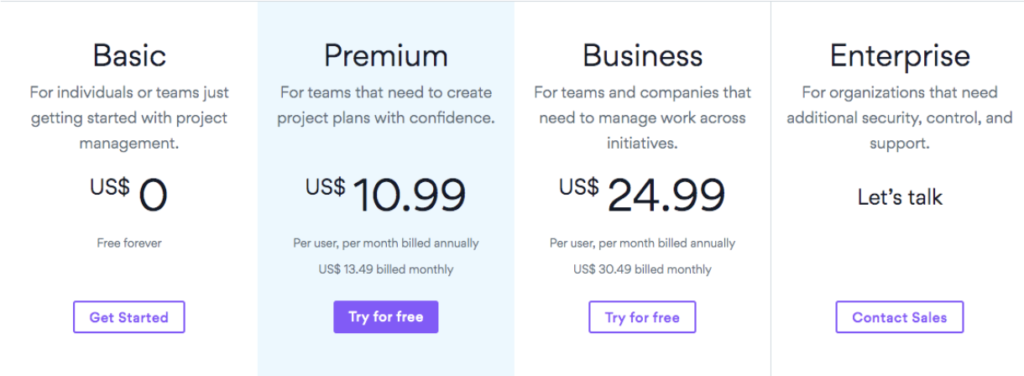
When to use?
- Your customer segments are very different from each other w.r.t needs and business size.
- You have different offerings for different segments
- Your customers do not get overwhelmed with information overload i.e. understanding various plans in this model.
Per Active User Pricing:
This model charges only for active users. Therefore, the companies get the advantage of signing up for as many users as they want and pay only for the ones who use the product.
Benefits:
- No money wastage on non-active users: There would be some users who wouldn’t use the product as much or wouldn’t use it at all. So, the subscriber need not worry “what if my people do not use the product”. Once those users who fall in the active user criteria defined by the company would be charged for.
- Reduces skepticism about trying the product: The major concern of most businesses when they buy a new SaaS product remains that they would lose their money if the product doesn’t serve their purpose well. Per Active user pricing model eliminates this concern since businesses pay only for active users and users become active only when the product serves the purpose well.
Drawbacks:
- Forecasting Revenue gets difficult: From the sellers’ perspective, it becomes difficult to forecast revenue since it is difficult to forecast the number of users who would adopt the product to be considered as active users.
- Challenging to define “active”: It may get challenging for the business to define when would a user be considered as “active”. Adding a lot of conditions for a user to be considered “active” may reduce the number of potential active users in the company and may affect the potential revenue for the business.
Example: Slack, the leading communication tool for businesses, uses a fair billing policy. If an active user becomes inactive, Slack returns the money for unused time. This pricing strategy removes any hindrance to product adoption and gives the customer the best value for money since they pay only for what they used.
When to use?
- You want more Enterprise customers (large number of users) to buy your product
- When it’s not challenging for you to define active users for your product
- Your customers are skeptical about deriving enough value from the product
Per Feature Pricing:
This pricing model involves pricing the different plans on the basis of features present in them.
Benefits:
- Strong Upselling Opportunity: Feature-based pricing presents an upselling opportunity when users want to unlock new features. This pricing model presents a way to increase revenue through upgrades.
- Pricing based on costs: The business can price the plans on the basis of the value to the business and the customer for each feature.
Drawbacks:
- Difficult to gauge feature-wise value to customers: For some products, it becomes difficult to gauge how much each feature is valued by the customer. Hence, overpricing a feature may discourage adoption.
- Customer Satisfaction may get affected negatively: Customers may feel that they are paying for the product every month but are not deriving maximum value out of it.
Example: Intercom is a SaaS product that helps you build better relationships with your customers through customer chat. It has priced its plans on the basis of the features present in each plan. The “Grow” plan consists of all the features in the “Start” plan and some additional features. Similarly, the “Accelerate” plan consists of all the features in the “Grow” plan and some additional features as well.
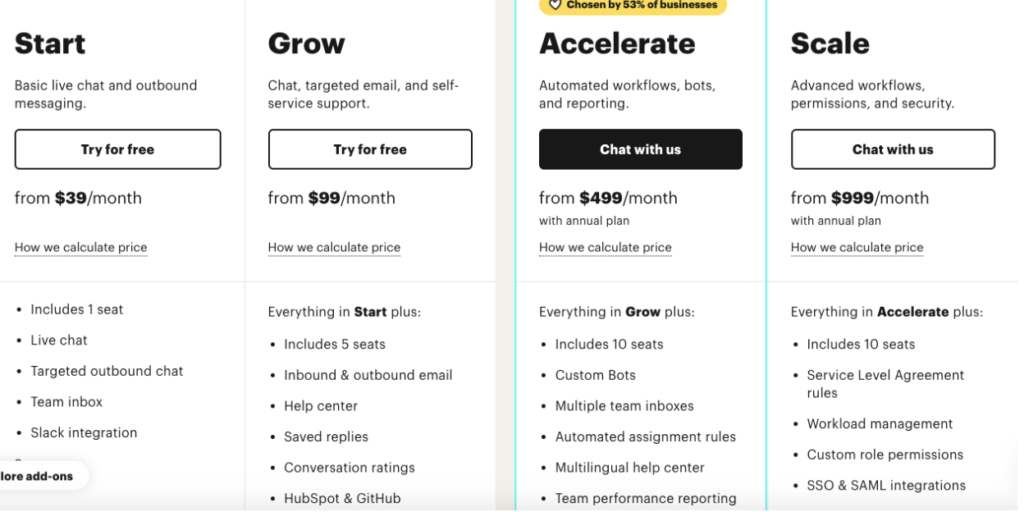
When to use?
- Your customers fall into different segments with varied needs
- Your customer understand their feature requirements clearly
Freemium Model:
Freemium model is widely used in the SaaS industry. Many SaaS companies offer the basic plan with a few features for free to encourage trial and then prompt the users towards upgrades to unlock other features.
Benefits:
- Easier acquisition: Freemium model is a good way to attract new users on the platform. It’s an acquisition technique used by a lot of SaaS businesses.
- Virality: Through a freemium model it is easier to achieve virality in a product since this model encourages adoption of the product.
Drawbacks:
- Revenue affected negatively: For a high chunk of users, the free plan may suffice, so they may never upgrade to the paid plan. Moreover, a cost is involved in acquiring every user. In such cases, the business may not be able to recover the cost of acquisition and has to bear revenue loss from such users who are deriving a lot of value from the product but aren’t paying for it.
- Customers may undervalue the product: If you give away the product for free, your customers might undervalue the product and eventually churn, because people do not value free give ways as much as the paid ones.
Example: Dropbox is a popular example of a product that achieved virality because of the freemium model and grew into a company with 200 million users. However, it got its revenue only from 1.6 to 4% of its total years.
When to use?
- You have a large Target Addressable Market for your product
- Your target segment is Small and Medium-sized Businesses
- When you expect the majority of your free plan customers to upgrade to a paid plan
Hybrid Pricing Model:
This pricing model is a combination of two or more pricing models. This model is used by companies that create value for the customer on various parameters. As a business grows and expands its customer base, using multiple pricing axes helps capture appropriate value from each customer. However, it is advisable for businesses to have not more than 3 pricing axes (2 is considered optimal).
Benefits:
- Extract full revenue potential: When just a single pricing model doesn’t do justice to a product’s value, it is better to use a combination of two or more pricing models to extract the product’s full revenue potential.
Drawbacks:
- Complicated pricing: The Hybrid pricing model may become difficult for the prospect to understand so it may take a longer time for the deal to close.
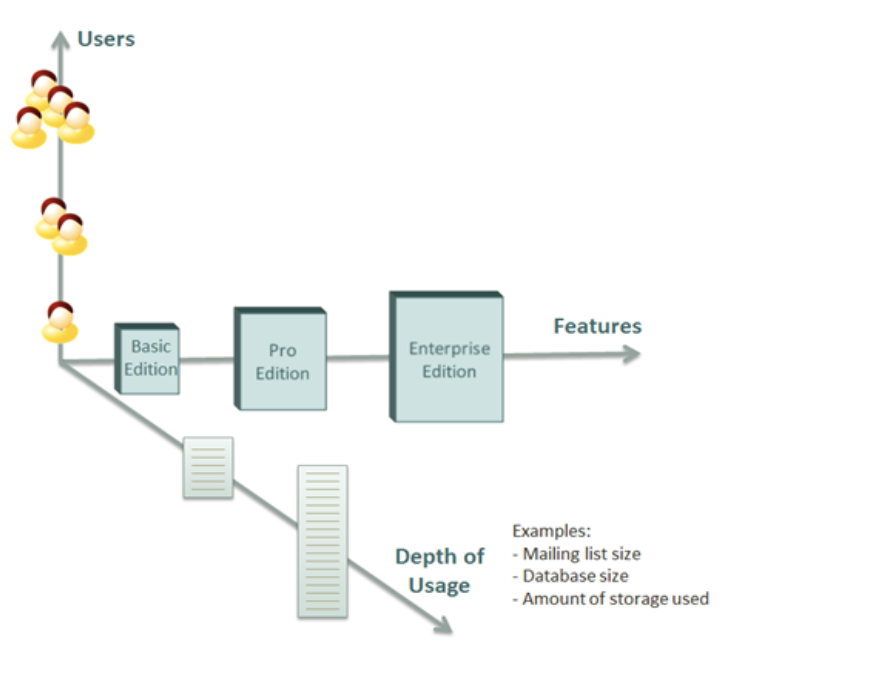
Example: Docusign, a tool for e-signature tool, uses a hybrid pricing model. It uses user-based pricing and also places restrictions on the number of documents that can be downloaded in its pricing. Since DocuSign can differentiate its offering on the basis of the number of users as well as the number of documents downloaded, Hybrid pricing helps capture the full value that the product offers to its customers.
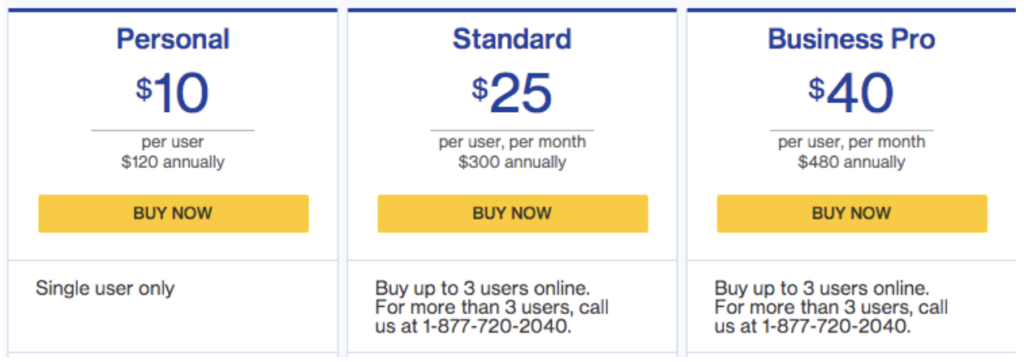
When to use?
- A single pricing model doesn’t help you capture the full value your product offers to customers
- Your customers do not get overwhelmed with complex pricing
- You can differentiate your pricing by more than one factor
A la Carte Pricing:
This pricing model is generally used when the customers are Enterprise businesses who have customized requirements. The price of the software varies for each customer depending on the requirement of the customers. The relevant features are added to the product as per customer’s requirements.
Benefits:
- Best for a wide range of customers: If you have a wide range of customers to cater to who have different requirements, then A la Carte pricing works the best for capturing the right value from the customers.
- Testing new features becomes easy: It is easier to try out new features when selling to enterprise businesses because if a feature does not work out, it affects only one customer rather than the entire customer base.
Drawbacks:
- Pricing for each customer becomes a tedious task: Since the pricing is different for each customer on the basis of their individual requirements, calculating the new price for every customer becomes a tedious task.
Example: Leena AI is an HR SaaS product that automates Employee Experience using conversational AI. It creates customized products on the basis of customers’ requirements and hence uses A la Carte pricing to price its product.
When to use?
- Your target Enterprise customers
- All customers are different w.r.t. their requirements
- You incur additional costs to customize your product for each customer
Volume Based Pricing:
Volume-based pricing is a type of pricing where a particular range of the number of users or number of times a feature can be used have the same price and the price per unit decreases with the next price range. For example, an email marketing tool can allow sending 100 emails for $10 where the price per sent email is $0.1 whereas the next price range i.e. sending 200 emails costs $15, which means that the price per email is $0.075. The price/email sent is reduced with an increase in the volume of emails.
Benefits:
- Helps bulk selling: Volume-based pricing helps in increasing the ticket size since the per-unit price decreases with an increase in the volume of purchase. This pricing model provides an incentive for the customers to purchase the product licenses in bulk.
Drawbacks:
- Loss of Revenue: The business loses revenue on each unit with an increase in the volume of purchases.
Example: Microsoft and Adobe are known for Volume licensing its products. Another tool Sketch, a vector graphics editor, uses a volume licensing strategy to encourage customers to purchase licenses in bulk.
When to use?
- You want to encourage your customers to purchase your product license in bulk
Time-Based Pricing:
There are certain SaaS products that save you time and hence such SaaS companies find it profitable to charge on the basis of per unit time the product is used. If the main value proposition and the Unique Selling Point of your product are saving time, then Time Based Pricing works the best by capturing the appropriate value of the product from your customers.
Benefits:
- Increases Engagement: Since the tool is accessible to the customers for a limited time, they ensure that they make the most of it. Hence, the engagement on the product increases on a daily basis. This pricing strategy helps increase the Daily Active Users and Monthly Active users on the product.
Example: Phantombuster is one of the widely used tools to extract data from the web to get leads. It prices its plans on the basis of the time available for use each day. In the Free Forever Plan, only 10 minutes per day is available for use whereas in the Premium plan 60 hours of use is available per day for all the Phantoms in total.

When to use?
- Your product’s value proposition and USP is saving the customer’s time
Getting the SaaS pricing model is essential for every SaaS business because it is the foundation with the help of which SaaS businesses generate recurring revenue. The pricing model should align with the value of your product to the customers, the cost to the business, and the goal of the business.
If you are facing challenges in finding the best pricing model for your SaaS product, feel free to me. I’d be happy to help.

